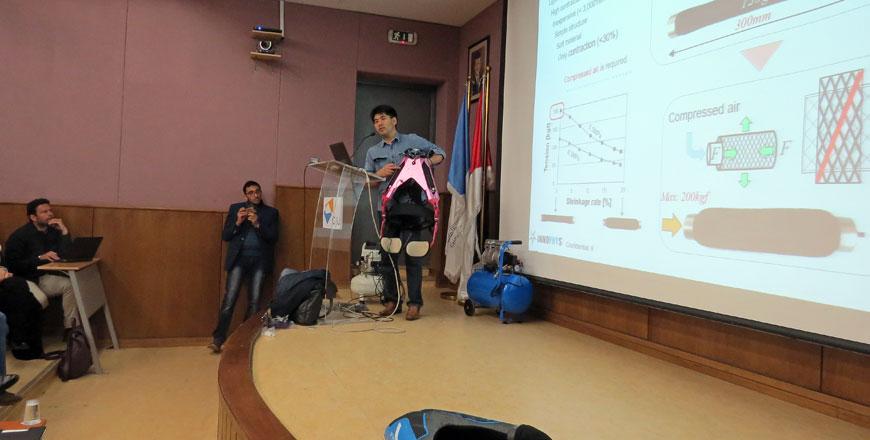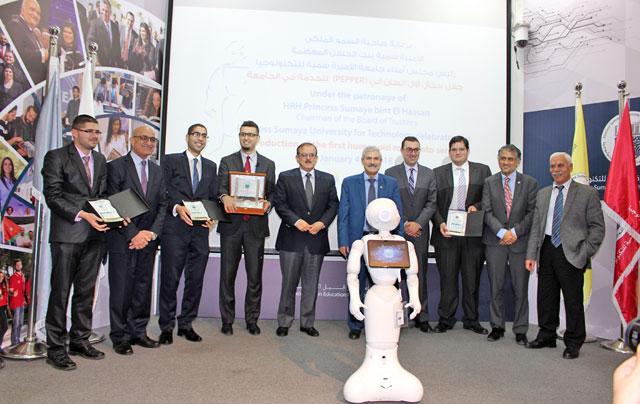You are here
Solve ‘worst thing’ you can imagine, Japanese inventor urges Jordanian students
By Dana Al Emam - Mar 07,2017 - Last updated at Mar 07,2017

Japanese inventor Hiroshi Kobayashi speaks to students at the faculty of engineering at the Princess Sumaya University for Technology in Amman on Monday (Photo courtesy of Japanese embassy)
AMMAN — Young inventors should strive to solve what they consider the “worst thing to happen”, while always being aware of how to further develop their projects in the future, a Japanese inventor visiting Jordan said on Monday.
In an interview with The Jordan Times on the sidelines of a workshop at the faculty of engineering at the Princess Sumaya University for Technology (PSUT), Hiroshi Kobayashi said that for him, the worst thing to happen to a human is to become bedridden.
A professor at Tokyo University of Science since 1998 and the founder of the Innophys company in 2013, he has invented several devices that facilitated the movement of bedridden individuals and people with physical disabilities.
Kobayashi, who believes in enabling all people to move independently, has 55 patents, including 15 sold patents.
His inventions include the muscle suit (exo-muscle) for lower back support, which helps users to carry objects weighing up to 40kg. The muscle suit has sold over 2,200 units in nearly three years.
Another of Kobayashi’s inventions is the active walker, which employs McKibben artificial muscles to operate through air contraction. The device helps bedridden individuals and people with physical disabilities to walk with correct posture.
His belief in the importance of independent movement was the starting point for his development of the muscle suit.
The suit, which is a wearable motion-assist system that controls joints’ torque, weighs 6kg and takes the user only 10 seconds to put on.
Over 200 companies in various sectors are using the muscle suit, including those working in construction and centres that provide services for bedridden people, allowing workers using the suit to carry patients, Kobayashi said in the workshop.
Commenting on his experience as an inventor, he said it is very rewarding when he sees that his invention has brought hope to many people and made them happy.
“Innovators must always accept customers’ complaints and seek to advance their products accordingly,” he added.
For example, Kobayashi is currently working on reducing the weight of the suit from 6kg to only 3.5kg.
Nonetheless, he acknowledged that success in the field requires patience and persistence to overcome obstacles, while also noting that academia and industry must always work in synergy.
“There is no border between academia and business.”
Other inventions developed by Kobayashi include Humanoid SAYA, whereby he added facial expressions to the SAYA robot to allow further emotional communication, with the robot expressing emotions of fear, disgust, anger, happiness and sadness.
Fifth year biomedical engineering student Ahmad Abu Ghaush said it was “interesting” for him to learn more about exoskeletons, which are part of his studies at the PSUT, while also being able to try out the muscle suit.
“I watched videos about the muscle suit over two years ago,” he said, adding that he is glad he got the opportunity to meet Kobayashi and learn more about the applications of the suit, and how it can be adjusted to serve multiple purposes.
Lamees Obeidat from the Japanese embassy’s cultural department said Kobayashi has also visited the German Jordanian University and the Royal Medical Services, where he presented and demonstrated his inventions.
She added that this visit is part of the cultural department’s annual series of events that bring Japanese experts in several fields to Jordan to talk about their expertise, in a bid to enhance educational and cultural exchange between Jordan and Japan.
Related Articles
AMMAN — A new patent has been registered in the name of Princess Sumaya University for Technology (PSUT) with the US Patent and Trademark Of
AMMAN — President of the Princess Sumaya University for Technology (PSUT) Mashhoor Al Refai on Thursday announced the introduction of the fi
AMMAN — What does it take to become an inventor that can make a difference? After all, the prosperity of an entire country might be a g

















